

Newton's Law of Gravity. Faster then light travel.
Physics Simulations and Artwork. Education. The Feynman Lectures on Physics. Angular Momentum. Antimatter:Mirror of the Universe. Earth. Earth has Ring Of Anti-Protons. Want to stay on top of all the space news?
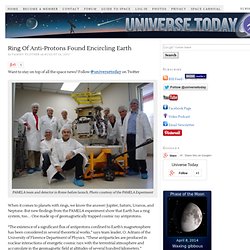
Follow @universetoday on Twitter PAMELA team and detector in Rome before launch. Photo courtesy of the PAMELA Experiment When it comes to planets with rings, we know the answer: Jupiter, Saturn, Uranus, and Neptune. But new findings from the PAMELA experiment show that Earth has a ring system, too… One made up of geomagnetically trapped cosmic ray antiprotons. “The existence of a significant flux of antiprotons confined to Earth’s magnetosphere has been considered in several theoretical works.” says team leader, O. The PAMELA experiment – short for Payload for Antimatter Exploration and Light-nuclei Astrophysics – is based on an international collaboration involving about 100 physicists. From its subdetectors, PAMELA dished up a serving of antiprotons, but it wasn’t an easy job. For 850 days, the detectors collected data and compared it against simulations. Original Story Source: Astrophysical Journal Newsletters.
Press Release. Geneva, 17 November 2010.
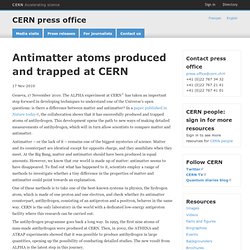
The ALPHA experiment at CERN1 has taken an important step forward in developing techniques to understand one of the Universe’s open questions: is there a difference between matter and antimatter? In a paper published in Nature today, the collaboration shows that it has successfully produced and trapped atoms of antihydrogen. This development opens the path to new ways of making detailed measurements of antihydrogen, which will in turn allow scientists to compare matter and antimatter. The Antimatter Factory - What is the AD? Antimatter Decelerator - Story. CERN traps antimatter atoms for 16 minutes. A team of particle physicists at CERN's Antihydrogen Laser Physics Apparatus (ALPHA) have trapped 309 atoms of antimatter for more than a quarter of an hour.

When CERN first created and trapped antimatter, back in November 2010, researchers held onto the fleeting antihydrogen atoms for just 170 milliseconds, or a tenth of a second. Antihydrogen atoms have a super short life span. As soon as they come into contact with normal hydrogen atoms the antimatter is annihilated. The team at ALPHA figured out how to isolate the atoms and hold a cloud of them in a magnetic field, but it released the antimatter after a confinement time of just 172 ms. 'Antimatter' captured by CERN scientists in dramatic physics breakthrough. Measuring protons & anti-protons. In a bid towards better understanding the inner workings of the proton, researchers in Germany have, for the first time, directly measured magnetic spin-transitions of a single trapped proton.
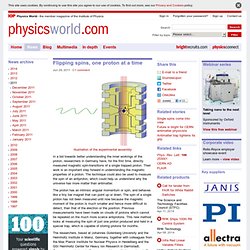
Their work is an important step forward in understanding the magnetic properties of a proton. The technique could also be used to measure the spin of an antiproton, which could help us understand why the universe has more matter than antimatter. The proton has an intrinsic angular momentum or spin, and behaves like a tiny bar magnet that can point up or down. CERN traps antimatter atoms for 1,000 seconds « Eideard. Haven’t your own antiproton decelerator?
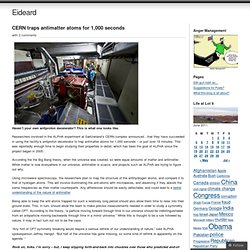
This is what one looks like. Antimatter atoms produced and trapped at CERN during 1000 seconds
Spherical electrons, gravitons, banes, super-symmetry. Something from nothing. The Ultimate Field Guide to Subatomic Particles. This is, for the most part, an accurate article, except for a few statements.
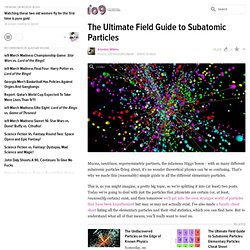
"Exactly what makes a fermion a fermion is a bit complicated, but suffice it to say that fermions are all the particles that deal with matter. So what about the last group of elementary particles, the ones that don't deal with matter? These are the bosons, and they deal with the fundamental forces of the universe. " The statements above can be misinterpreted as suggesting that fermions are defined as particles that deal with matter and bosons are defined as particles that deal with forces. And that is not true. Particles that deal with matter are fermions and particles that carry the fundamental forces are bosons. What fermions and bosons really are have to do with two apparently unrelated (but actually related) particle properties: spin and statistics.
"There are four known bosons" See, this is an example of the misconception I just mentioned. According to special relativity, not general relativity. New particle- neutral Xi-sub-b. A new sub-atomic particle has been discovered by physicists using high-energy collisions at the U.S. national laboratory Fermilab.
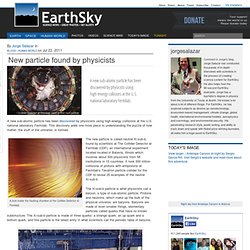
This discovery adds one more piece to understanding the puzzle of how matter, the stuff of the universe, is formed.
Albert Einstein and the Theory of Relativity. Everett's Relative-State Formulation of Quantum Mechanics. First published Wed Jun 3, 1998; substantive revision Fri Sep 10, 2010 Hugh Everett III's relative-state formulation of quantum mechanics is an attempt to solve the quantum measurement problem by dropping the collapse dynamics from the standard von Neumann-Dirac formulation of quantum mechanics. Everett then wanted to recapture the predictions of the standard collapse theory by explaining why observers nevertheless get determinate measurement records (or at least appear to do so) and by accounting for quantum probabilities.
It is, however, unclear precisely how this was supposed to work. There have been several attempts to reconstruct Everett's no-collapse theory in order to account for determinate measurement records and quantum probabilities. These attempts have led to such formulations of quantum mechanics as the many-worlds, many-minds, many-histories, relative-fact, and bare theories. 1. Sonarluminescence- is this nuclear fusion? PHYSVIDS: Science videos physics shorts: odd & weird. Homepage. Il Nuovo Cimento (1955-1965), Volume 8, Supplement 2. Extreemly Dangerous. Large Hadron Collider. The Large Hadron Collider (LHC) is the world's largest and most powerful particle collider, most complex experimental facility ever built, and the largest single machine in the world.[1] It was built by the European Organization for Nuclear Research (CERN) between 1998 and 2008 in collaboration with over 10,000 scientists and engineers from over 100 countries, as well as hundreds of universities and laboratories.[2] It lies in a tunnel 27 kilometres (17 mi) in circumference, as deep as 175 metres (574 ft) beneath the France–Switzerland border near Geneva, Switzerland.
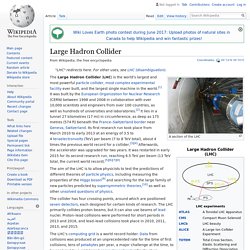
Its first research run took place from March 2010 to early 2013 at an energy of 3.5 to 4 teraelectronvolts (TeV) per beam (7 to 8 TeV total), about 4 times the previous world record for a collider,[3][4] Afterwards, the accelerator was upgraded for two years. It was restarted in early 2015 for its second research run, reaching 6.5 TeV per beam (13 TeV total, the current world record).[5][6][7][8] Background[edit] Cost[edit] The Scale of Things. Electro Magnetic Spectrum. Astronomy. Giant Simulation Could Solve Mystery Of 'Dark Matter'
Measurements. Cosmos - Speed of Light. Dark energy. Adding the cosmological constant to cosmology's standard FLRW metric leads to the Lambda-CDM model, which has been referred to as the "standard model" of cosmology because of its precise agreement with observations.

Dark energy has been used as a crucial ingredient in a recent attempt to formulate a cyclic model for the universe.[8] Nature of dark energy[edit] Probability & Quantum State.